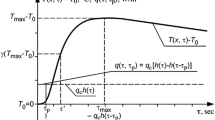Summary
Heat flux meters are analysed asymptotically for small thickness/width ratios. The gain of the meter is calculated for several examples, both two-dimensional and axisymmetric. Ideal and optimum designs for meters are suggested.
Similar content being viewed by others
References
M. Abramowitz and L. A. Stegun (eds.), Handbook of Mathematical Functions. National Bureau of Standards,Applied Mathematics Series No. 55, Washington, D.C. (1964).
H. Lamb,Hydrodynamics (6th edn.) Cambridge and Dover (1932).
N. I. Muskhelishvili,Singular Integral Equations (Translated by J. R. M. Radok) Groningen, Holland, Noordhoff (1963).
J. R. Philip, The theory of heat flux meters.J. Geophys. Res. 66 (1961) 571–579.
D. J. Portman, Conductivity and length relationships in heat-flow transducer performance,Trans. Am. Geophys. Union, 39 (1958) 1089–1094.
P. Schwerdtfeger,The measurement of heat flow in the ground and the theory of heat flux meters. Cold Regions Research and Engineering Lab. Report, Hanover, New Hampshire, November (1970).
B. Thwaites (ed.),Incompressible Aerodynamics, Oxford (1960).
F. G. Tricomi,Integral Equations, Interscience (1957).
M. Van Dyke,Perturbation methods in fluid mechanics. Academic Press (1964).
Author information
Authors and Affiliations
Rights and permissions
About this article
Cite this article
Tuck, E.O. A theory for the design of thin heat flux meters. J Eng Math 6, 355–368 (1972). https://doi.org/10.1007/BF01535196
Received:
Issue Date:
DOI: https://doi.org/10.1007/BF01535196




